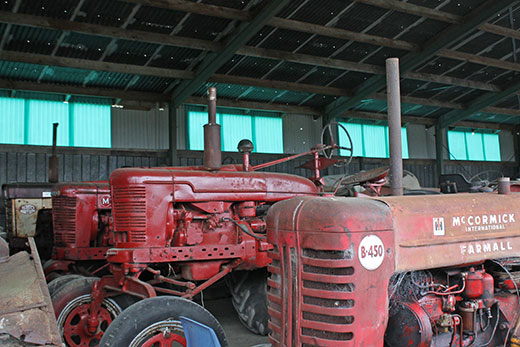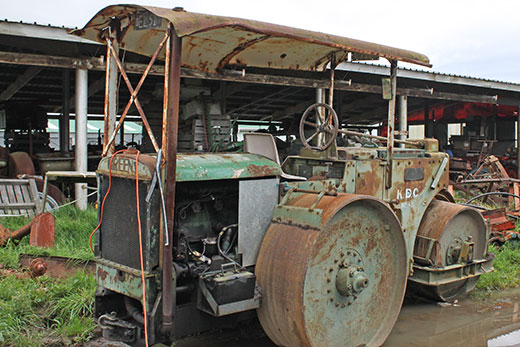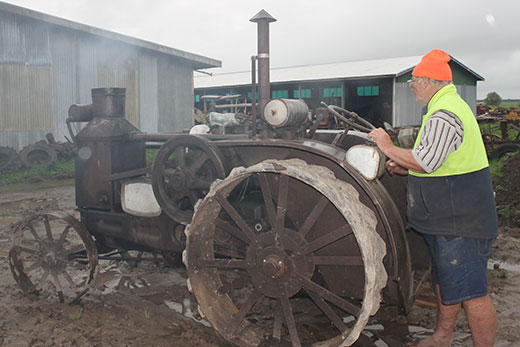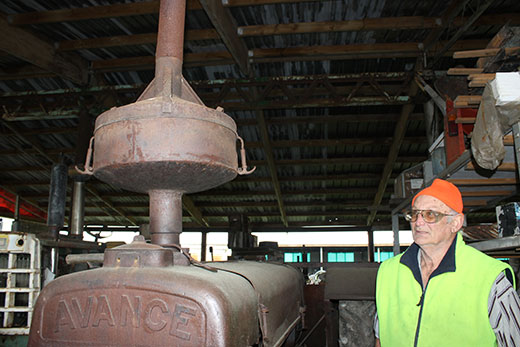Jim Richardson is well-known in Edgecumbe for two things – his extremely large collection of tractors, and the fact he hasn’t worn shoes since he left school.
“I don’t like shoes. Only wear them for weddings, funerals and when I travel on commercial flights – but I take the shoes off as soon as the plane is in the air,” says Jim, as he walks through puddles leading gumboot-shoed followers on a guided tour of sheds full of an estimated 400-plus tractors.
“I particularly like odd-ball tractors – ones which not many were made of, or have been used for specialised jobs, or are just unusual.”
Accordingly, every tractor or bulldozer in Jim’s sheds has a story.

McCormick tractors of many shapes and sizes are part of the collection.
“This McCormick Farmall Cub used to pull the baggage cart out to the NAC aircraft at Gisborne Airport and it’s still got its original colours and the NAC sign. Not many people today know that NAC stands for National Airways Corporation.”
NAC was the national domestic airline of New Zealand from 1947 until 1978, when it amalgamated with New Zealand’s international airline, Air New Zealand.
Then there’s the rather decrepit-looking tractor with a pully-operated front-end loader used during sulphur mining operations on White Island, which finally ceased in the 1930s.
Horse hair filter
A number of Jim’s tractors have been modified by their manufacturers, to suit specific roles like those with a wider wheelbase and higher clearance for cropping, or tractors which are lowered with narrow wheelbase for orchard work.

The Oliver tractors are among Jim Richardson’s favourites.
He’s imported tractors from America and Australia as well as collected them from around NZ. “I guess I’ve saved a lot from going into scrap.”
‘Odd-ball’ is certainly a fitting description for the appearance of the big American Advance tractor with its oversized front-mounted air filter. “These air filters were filled with oil and horse hair to stop the dust and dirt of the prairies getting into the engine and damaging it. However, there was no protection for the driver – he just had to put up with the dust.”
Among Jim’s favourite make of tractors is the Oliver brand and he’s got several. Not all are odd-ball but Jim likes their style and design.
According to Wikipedia, The Oliver Farm Equipment Company of American was formed as a result of a 1929 merger of four companies: the American Seeding Machine Company of Richmond, Indiana; Oliver Chilled Plow Works of South Bend, Indiana; Hart-Parr Tractor Company of Charles City, Iowa; and Nichols and Shepard Company of Battle Creek, Michigan.
Changes the name
Jim also has a Hart-Parr New Zealand Special Tractor – made by one of Oliver’s founding companies, which was the first to coin the word ‘tractor’. W H Williams, who was Hart-Parr sales manager in 1906, decided the words ‘traction engine’ were vague and too long to be used in press releases, so he came up with the word ‘Tractor’, a combination of the words traction and power, instead.

Most of Jim Richardson’s collection are tractors, but this road roller is an exception.
There’s one machine Jim has given his own name – it’s a Rumely Oil Pull traction engine called ‘Helen’ “because it gave me a lot of trouble – I’ll say no more”.
When Jim acquired it the giant and very old machine was in pieces, packed on 12 pallets. “I did have a manual but every time I got to something complicated it advised calling the manufacturer. Well that wasn’t going to work was it?”
Eventually, Jim reassembled the machine and got it working. He has another smaller version he regularly takes to vintage machinery shows. Both are representative of Rumely’s most famous product, the kerosene-powered Rumely Oil Pull traction engine, first developed in 1909.
The Rumely Oil Pull was the first tractor to use an oil cooling system, which kept the engine at a steady temperature no matter how heavy the tractor’s load. The cooling system allowed hotter cylinders and easier ignition. The Oil Pull starts on gas but runs on kerosene, making it much lighter and easier to maneuver than its steam-driven predecessors.

Jim Richardson fires up the Rumely Oil Pull traction engine he regularly takes to machinery shows.
Never froze up
“The beauty of tractors which ran on kero is that they need to be hot to run good, so they were ideal in the winter in the [United] States because they never froze up.”
Jim’s interest in tractors began when he was a child growing up on the family farm at Edgecumbe. “My dad taught me practical things. I learnt to weld when I was still at primary school.”

This tractor with a pully-operated front-end loader was used during sulphur mining operations on White Island.
However, he has no formal training in engineering or mechanics but there’s not much about restoring old machinery that stumps him. What he can’t source from other collectors he either makes himself or has engineered.
Throughout his sheds there are dozens of tractors under restoration – more projects that Jim reckons he’ll have time to complete.
Why does he keep them all? “Otherwise they’d end up as scrap and there’s so much history here. I like old machinery because, with a bit of time and know-how you can get most of it going again – even machines 80 or more years old will still do a good day’s work.
“Modern tractors with all their computer systems – you can’t work on them yourself and they have a limited life.”
Jim’s knowledge of his tractors is impressive and well-researched – if old-school. “I don’t have a computer. I find out what I need to know by talking to other people.”



0 Comments
Leave a Comment